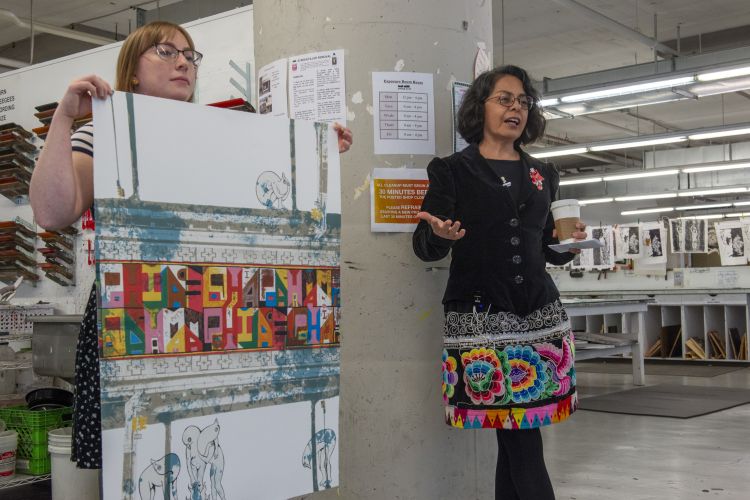STORIES FROM PAFA
An Old Dog Inspires New Tricks for Painter Sarah McEneaney at the Brodsky Center
“I’m primarily a painter”—an understatement from PAFA alumna Sarah McEneaney, whose autobiographical paintings can be seen in permanent collections from coast to coast—"but I have made some sculpture in the past throughout the years and they've mostly been animals. I think that’s because I live with animals and I touch them.” A pet cat interrupted her words by rubbing its face on her computer screen. "Something about that tactile sense made me feel like I could sculpt them.”
In Spring 2019 McEneaney set to work constructing the original shape, or matrix, of a new sculpture out of plasticine, all the while staying in communication with collaborators at PAFA’s Brodsky Center. She describes it as a life-size bas relief of her beloved pet dog, Mango, on a large piece of plywood. (The closest parallel is a slip casting of another dog, Daisy, she completed several years earlier.) “Then Covid hit and everything kind of came to a screeching halt,” says McEneaney. The artists and makers pivoted to Zoom conversations, discussing the process and materials. “We were kind of in a holding pattern for a while until I was able to go in and work with Nicole Donnelly on the next steps.” John Grieg made a five-piece mold with latex and plaster, allowing for the unusual curves needed to create Mango’s canine figure. “My dog had a lot of undercuts,” she admits.
Once McEneaney and colleagues were vaccinated, she was able to visit the Brodsky Center again in person, when her two-week residency truly began this past May. She was shown a plain white form of Mango, using her custom mold and uncolored handmade paper. Next was making the sheets to be used for a full edition of the Mango casts. The initial plan was to depict the dog—a miniature Pinscher mix—with realistic coloring, complete with the light brown eyebrows that show his expressions amid his darker fur. But in the end, Mango’s likeness will live up to its fanciful name, with variations of oranges, yellows, reds, and greens harkening to the tropical fruit in stages of ripeness. McEneaney leaned on the expertise of Donnelly at the Brodsky Center, noting the surprises in papermaking along the way. “My first couple days I was just being careful with little bits of color here and there, as if I was making a little painting. But making paper—it's very physical. You pour that pulp and it's integrated into the paper itself. It's not sitting on top of it the way paint sits on canvas,” she says. “This was all new to me,” and a project that would not have been possible without the support of the Brodsky Center.
“The main part of their mission is to help artists realize a project they wouldn't be able to do otherwise,” she says. ‘Expert’ is the word McEneaney uses most to describe the support she received: “There’s no way I could be making this thing. I don't have the expertise. I don't have the set-up. But I have my ideas, and then Nicole figures out how to get what I want, knowing the media as well as she does. I had complete faith in her.” In all, they have created 42 sheets of paper from deeply layered colors and pulp. With careful pairing and using the mold, they will creates sixteen Mangos: ten for the edition, plus artist proofs, proofs for the Brodsky’s archive, and educational tools for the PAFA students who come through the center. “To me they're all lovely, but they're all unique. It's as if there are ten siblings!
Each part of the edition, titled Mango Mango, will be available for sale when the work is completed in September, but the little pup’s legacy will live on long past this edition, surely a comfort to him as he dreams of greatness, curled up on a small couch in McEneaney’s studio. “My work often references itself. A depiction of the Mango sculpture has already ended up in a newer painting as if it's a famous sculpture hanging on the wall in my living room.”
—Diana Wensley, content writer
About the Brodsky Center
The Brodsky Center at PAFA empowers artists to explore, experiment, and extend boundaries by creating new work in collaboration with master printers and papermakers. Since its founding in 1986 by Judith K. Brodsky, it has purposely and proudly engaged artists of color and women artists as well as other underrepresented communities. With a commitment to Philadelphia’s diverse neighborhoods, the Brodsky Center advances PAFA’s reach locally and internationally by educating students, promoting the singular work and innovative ideas of influential artists, and inviting all audiences to appreciate the relevance of paper and print in contemporary arts and culture.




We're so excited you're planning to visit PAFA!
Make time for art — visit us Thursday to Sunday.
Before reserving your tickets, please review helpful information about museum hours, accessibility, building access, and special admission programs.
If you have any questions, feel free to reach out to us at visitorservices@pafa.org — we’d love to help!



